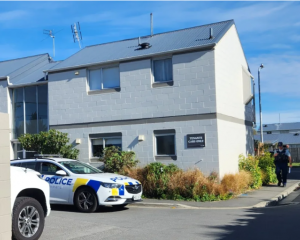
In late August they promised 40 to 50 security assessments of shops each week, but they have done less than half that - about 15 a week.
The government told RNZ the assessments had been "accelerated".
- Dairy owner faces 13yo ram-raider
- Camera shop, convenience store targeted
- Canterbury dairy targeted for third time
- Ram-raid, burglary in Christchurch
In mid-October, it said the rollout was too slow.
An Official Information Act response shows, as of November 4, a total of 118 stores had been assessed.
Footage of the ram-raid at Thirsty Liquor on Centaurus Rd, Huntsbury.This compares with the 280-350 promised by police who said on August 30 they were adding a dozen staff by mid-September - "which will enable us to be doing 40 to 50 assessments per week".
Despite promises of "pace" by October 27, only seven stores nationwide had installed any protective equipment at all, such as bollards.
It took police two months to move from five installations to seven, in a period when they added staff and also got approval to fast-track who they bought protective equipment from.
Installations have been commissioned for a further 64 shops.
Police internal spending has been much less than expected.
Other OIAs show police have not had good data on ram-raids, but that they did not follow an internal recommendation to fix the gap.
There has been difficulty getting the work contracted, police deputy commissioner Jevon McSkimming told Morning Report.
"We have contacted 187 stores, of those 104 have had their assessments done and 71 of those have been contracted out for contractors to deliver those services."
A number of new staff have been put in place to facilitate the link between the shop and the contractor, McSkimming said.
The supply chain was also limiting the speed at which things could be put in place, he said.
Unable to spend it all in time
Nevertheless, ram-raids have been dropping from their high of 10 a week, according to police in early November.
This followed the arrests of several hundred young people in Auckland and Waikato in recent months, with more than 2000 charges laid in the two regions.
The OIA responses showed police did not expect to be able to spend all of the $6 million budget by July 2023, the end of the financial year.
"We consider it unlikely that we can roll out this programme within a single financial year," they told Police Minister Chris Hipkins on 25 August.
They then sought his approval to carry the funding forward into 2023-24.
"A case for this needs to be made later in this financial year," the police briefing to the minister stated.
The Proceeds of Crime Funding requirements of the $6m entail it all be spent in 2022-23.
The August report was the sole briefing the minister got from police on the ram-raid rollout. Hipkins told RNZ he also got regular oral updates.
In mid-October, he said the rollout had been "too slow" but "we're starting to see that progress accelerate".
He told RNZ last week that police now had 12 assessors "to lift engagement with retailers and ensure on-site assessments are done as quickly as possible".
In the August briefing to Hipkins, police said they had "a focus to deliver at pace and volume", though at that stage they had yet to finish designing the rollout.
Last Thursday, police told RNZ they were "working at pace".
However, while they had expected to spend $400,000 internally on the programme by 30 June, by 4 November they had spent just $171,000 - though this was a step up from August, when they had spent just $7400 - the OIAs show.
The rollout aims to help up to 500 retailers, though there are thousands of small store owners nation-wide.
In late August police were still working on the criteria to decide on the "next wave" of which businesses would be eligible.
"Installing bollards at one store which has been previously impacted by ram-raids, does not necessarily mean that a neighbouring retail business will then be at risk of a ram-raid," police said in the OIA.
Under the programme, each retailer is assessed case-by-case, to determine which security upgrades are necessary, with options ranging from bollards or fog cannons to sirens, alarms, roller doors, or simply advice on preventing crime.
'Weakness in the data'
One hurdle has been "a weakness in the data", a previous police OIA said.
Some officers had been recording a burglary specifically as a ram-raid for years, but others had not, it said, referring to a report from the National Intelligence Centre in January.
"It is therefore possible that ram-raid style burglaries were missed" or counted when they should not have been, it said.
"The inconsistent manner in which ram-raids are described in reporting limits understanding of the ram-raid landscape within New Zealand," the National Intelligence Centre said.
It suggested in January that police create a "flag" specifically for ram-raids, in the files in their central national intelligence database (or 'application', the NIA).
RNZ asked if police had done this; they said they had not.
"There has been no update to the National Intelligence Application flags to date to specifically record a 'ram-raid' occurrence, and there is currently no plan in place to progress this recommendation," police told RNZ.
"Should this work get endorsed and approved, it will require significant time and resource allocation."
No substantive report had been done on adding an NIA flag, they added.
The other recommendation in January was that police adopt a multi-agency approach alongside Oranga Tamariki, to engage with young people who had committed a ram-raid.
"This would help to provide a more targeted and tailored approach," it said.
Police told RNZ they did this through Family Group Conferences and the Kotahi Te Whakaaro programme.
Asked for the latest recommendations around the ram-raid programme, police said they did not have a specific list of recommendations.













